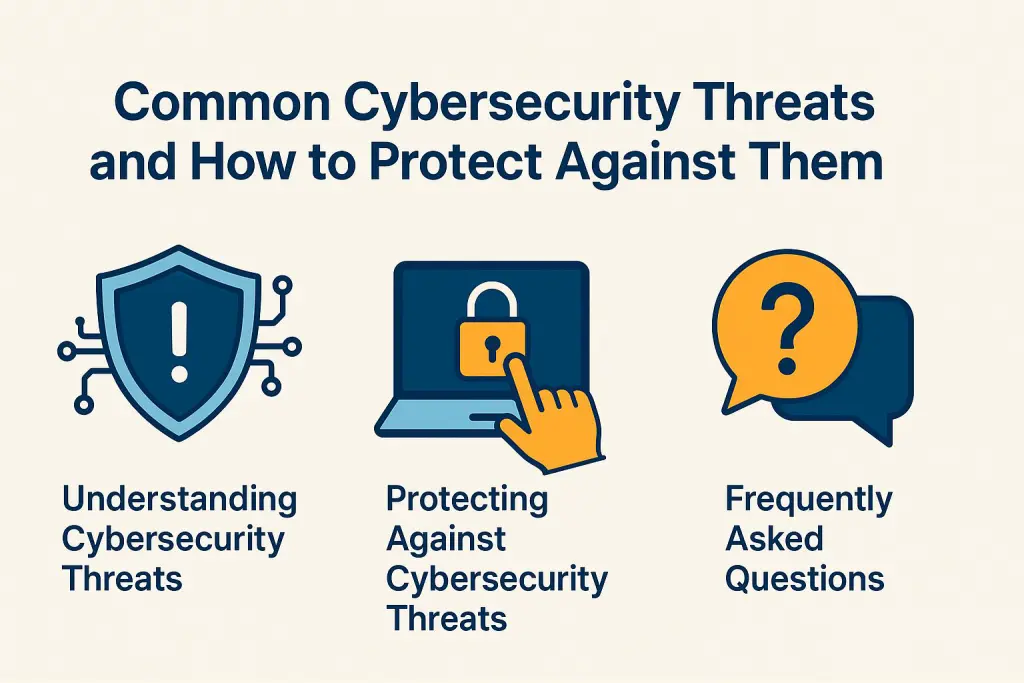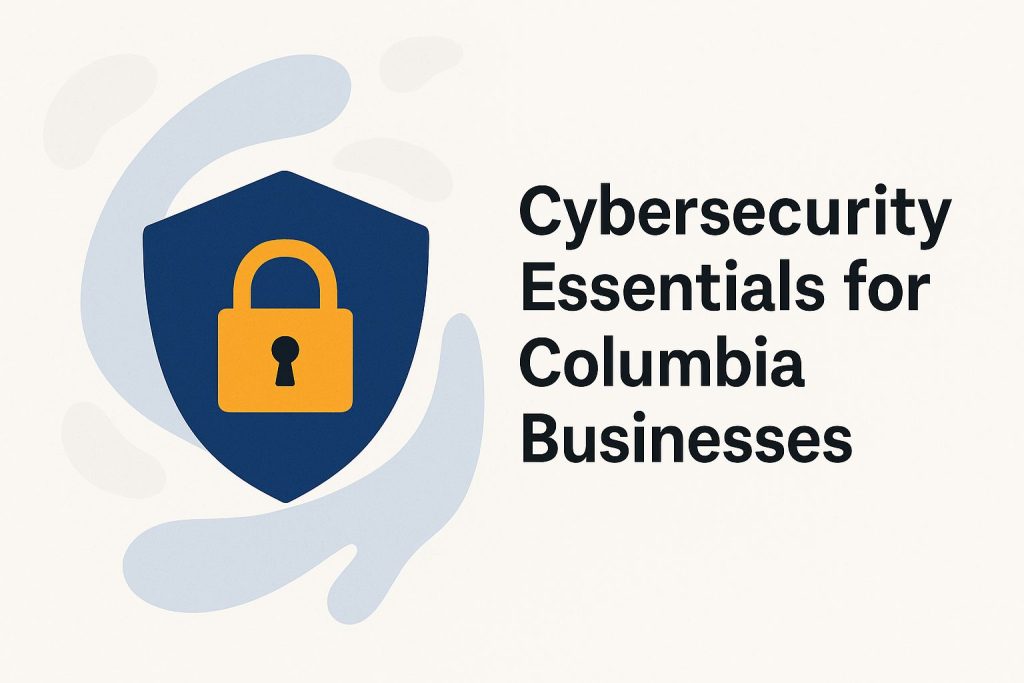Top Cybersecurity Threats Facing Columbia Businesses (and How to Prevent Them)

Today, cybersecurity is a big concern for businesses in Columbia. As threats evolve, companies must stay alert against various cyberattacks that can disrupt operations and compromise sensitive data. This article reviews current cybersecurity threats in Columbia. It highlights types of attacks and their impacts. It also explores effective preventative measures and outlines practical steps for response and recovery in the event of a cybersecurity breach. By staying informed, businesses can protect themselves against these growing threats.
Overview of Cybersecurity Threats in Columbia

The cybersecurity landscape in Columbia is complex. Various threats target local businesses and organizations. Cybercrime continues to evolve, requiring constant vigilance and advanced security protocols.
As cybercriminals evolve their tactics, Columbia businesses must be proactive in understanding risks, which include data breaches, ransomware, and insider threats.
Compliance with cybersecurity frameworks is crucial. It protects sensitive data and ensures resilience. Worth exploring: Columbia Cybersecurity: Stay Ahead of Hackers for strategies to maintain a proactive stance against these evolving threats.
This overview examines current trends, threats, and the importance of robust cybersecurity strategies to effectively mitigate these risks.
Current Landscape and Trends
Columbia’s cybersecurity landscape shows a rise in cyberattacks, including phishing and malware, with businesses confronting ongoing threats such as phishing attacks, malware, and DDoS attacks, all of which can severely disrupt operations and compromise sensitive data.
As companies adopt remote work, strong network security and endpoint protection are essential to safeguard digital assets. Understanding these trends is essential for businesses in Columbia that aim to enhance their cybersecurity posture and defend against emerging threats.
Digital transformation expands the attack surface, making advanced threat detection necessary. By implementing comprehensive network monitoring, companies can identify vulnerabilities and enhance their overall security framework against sophisticated threats.
Incident response strategies also become critical, enabling businesses to respond swiftly and effectively to breaches when they occur, thereby minimizing potential damage. An effective incident response plan should include digital forensics and ongoing security assessments.
Focusing on these areas helps organizations protect operations. It also strengthens resilience against the evolving cyber landscape.
Common Cybersecurity Threats Facing Businesses
Columbia businesses face various cybersecurity threats that can harm operations and reputation.
Among the most significant risks are: identity theft, regulatory compliance issues, and third-party risks.
- Phishing attacks, which trick employees into disclosing sensitive information;
- Ransomware, which restricts access to critical data until a ransom is paid;
- Data breaches that expose personal information, thereby undermining customer trust.
Furthermore, insider threats present a distinct challenge, as employees may misuse their access to sensitive data. Understanding these threats is vital for organizations to create effective prevention and response strategies through comprehensive IT security measures. In fact, IT security services in Columbia offer tailored solutions to address these challenges effectively.
Types of Attacks and Their Impact

Various types of attacks present distinct challenges for businesses in Columbia, each with the potential to inflict substantial damage. Security incidents can disrupt operational security and compromise system vulnerabilities.
Ransomware attacks can paralyze operations, while malware can compromise data integrity and security. Social engineering exploits human behavior to gain unauthorized access to systems, and DDoS attacks can disrupt online services and operations.
The impact of these threats underscores the necessity for robust cybersecurity defenses and proactive risk management strategies that include employee training and incident response plans.
Organizations must understand these threats and implement security measures like zero trust architecture:
- Conduct regular security audits. These audits identify vulnerabilities and ensure compliance with best practices. Patch management addresses software vulnerabilities.
- Conduct penetration testing. This simulates real-world attacks and uncovers weaknesses before malicious actors exploit them.
- Employing behavioral analytics to enhance threat detection by enabling businesses to monitor unusual user activity and respond swiftly to potential breaches.
Integrating these cybersecurity practices is essential for protection. They safeguard sensitive information and maintain trust in a digital landscape.
Preventative Measures for Businesses
Businesses in Columbia must implement effective preventative measures. This enhances cybersecurity and mitigates potential threats. Effective IT security policies are fundamental to this process.
This includes establishing strong security policies, conducting regular audits, and providing employee training on cybersecurity awareness.
Additionally, organizations must adopt effective risk management strategies to identify vulnerabilities and implement appropriate safeguards, such as firewalls, encryption, and two-factor authentication. If interested, Columbia companies can stay ahead of hackers with strategies outlined in our Columbia Cybersecurity guide.
These proactive measures help businesses create a strong cybersecurity posture. This is crucial in response to evolving cyber threats.
Best Practices and Strategies for Protection
Adopting best practices and strategic approaches is essential for Columbia businesses to effectively protect their digital assets from cybersecurity threats. Key strategies include:
- Implementing identity management protocols to ensure that only authorized personnel have access to sensitive information. Secure coding practices are also essential.
- Utilizing data loss prevention tools to safeguard critical data.
- Promoting cyber hygiene among employees through ongoing security awareness training.
By embracing these best practices, organizations can reduce their risk of cyber incidents. This strengthens their overall security posture. Cyber hygiene and cybersecurity awareness training are key components.
To establish a strong cybersecurity framework, organizations must address technical aspects and foster a cultural shift within the organization. Security metrics and IT governance play a crucial role in this.
Businesses should prioritize compliance with industry regulations, ensuring that their practices align with stringent standards.
Integrating operational technology security measures can further enhance company systems against potential breaches. Regular risk assessments and updates to cybersecurity policies are vital to adapting to the evolving threat landscape.
Building cyber resilience is critical for long-term security. Engaging employees in role-specific training cultivates an environment of vigilance, this proactive approach contributes to the organization’s overall security.
Steps to Take in Case of a Cyberattack

If a cyberattack occurs, businesses in Columbia must have a clear response plan. This plan outlines essential steps for effective incident management.
Immediate actions include activating technical controls and ensuring endpoint protection.
- Isolating affected systems to prevent further damage,
- Conducting a thorough investigation to determine the scope of the breach,
- Notifying affected parties in compliance with data protection laws.
Building cyber resilience is critical. Organizations must continuously improve and learn from incidents to enhance defenses against future attacks. For an extensive analysis of this trend, our IT Security Columbia | Cybersecurity Services examines practical strategies for enhancing cybersecurity.
Response and Recovery Plan
A robust response and recovery plan is essential for businesses in Columbia to minimize damage and restore normal operations following a cyberattack. This plan should encompass incident response procedures, clearly defined roles and responsibilities for team members, and a well-established communication strategy to keep stakeholders informed.
Organizations should also consider cyber insurance as a risk management tool to mitigate financial losses while ensuring business continuity through comprehensive recovery strategies.
This plan outlines steps to contain and eliminate cyber threats. It also ensures that critical operational technology systems are secure and recoverable. Assigning roles to team members improves accountability and efficiency. An effective communication strategy ensures information flows smoothly between teams and partners.
Using insights from past incidents helps businesses improve their strategies. This enhances the effectiveness of their response efforts. Investing in cyber insurance strengthens business continuity and disaster recovery.
By prioritizing these components, organizations can strengthen defenses, protect data, and improve resilience against future cyber threats.
Frequently Asked Questions
What are the most common cybersecurity threats facing Columbia businesses?
The most common cybersecurity threats facing Columbia businesses include phishing attacks, malware, ransomware, and insider threats.
How can businesses in Columbia protect themselves from phishing attacks?
To prevent phishing attacks, businesses should educate employees about how to identify and report suspicious emails, avoid clicking on links or attachments from unknown sources, and implement email filtering and security software.
What steps can businesses take to prevent malware attacks? Regular security updates and cloud security measures are also critical.
To prevent malware attacks, businesses should update their software regularly. They should also use anti-virus software and restrict access to sensitive information.
What should businesses do to protect against ransomware and DDoS attacks?
To prevent ransomware attacks, businesses should regularly back up their data, use strong passwords and multi-factor authentication, implement security training for employees, and engage in threat mitigation by utilizing cyber defense techniques.
How can businesses in Columbia guard against insider threats using cybersecurity measures?
To prevent insider threats, businesses should implement strict access controls and monitoring, conduct thorough background checks for employees, provide regular cybersecurity training for all employees and incorporate IoT security and mobile security strategies.
What other steps can businesses take to protect themselves from cybersecurity threats and maintain digital security?
In addition to the above measures, businesses in Columbia should implement network security protocols. They should regularly conduct security audits and have an incident response plan.




